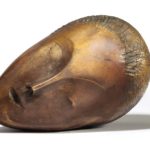
AMSTERDAM.- Research recently revealed that the Rijksmuseum’s monumental bronze statue of Shiva was cast in solid bronze. The thousand year-old temple statue was X-rayed, along with the lorry transporting it, in the most powerful X-ray tunnel for containers of the Rotterdam customs authority. It is the first research of its kind on a museological masterpiece. At 153 cm x 114.5 cm, the Rijksmuseum’s Shiva is the largest known bronze statue from the Chola Dynasty (9th to 12th century) kept in a museological collection outside of India. Given its weight (300 kg), the statue has always been suspected of not being hollow, as has been common practice in Europe since the Greek Antiquity. As part of an earlier investigation, an X-ray was taken of the statue in a Rijksmuseum gallery in 1999 while visitors were evacuated as a precaution against radiation. Unfortunately, the equipment used at the time (280 KeV) was not powerful enough to determine anything definitively. The Rotterdam X-ray tunnel of the Rotterdam customs authority offered a solution. Normally used to scan sea containers for suspicious contents, the high-energy digital radiation (9.3 MeV) offers sufficient resolution and range to distinguish between a 1mm copper wire and a 30 cm piece of steel.







